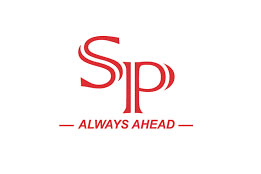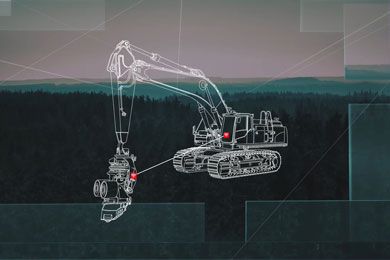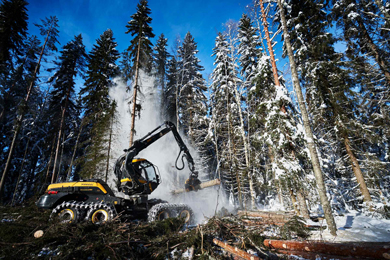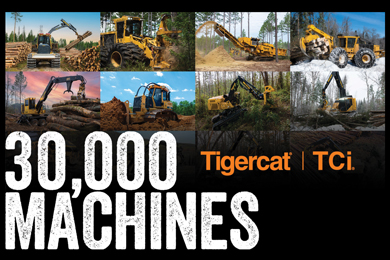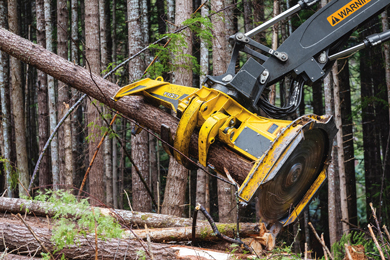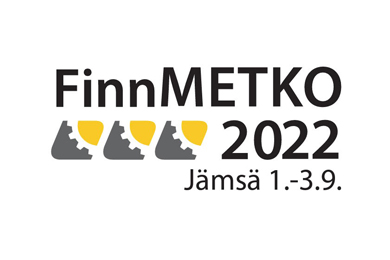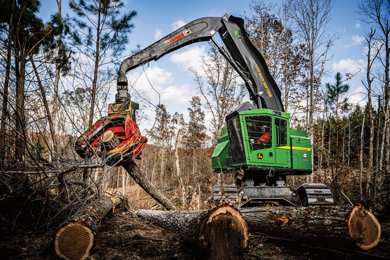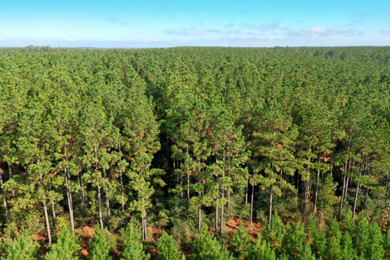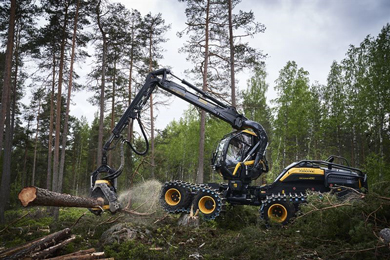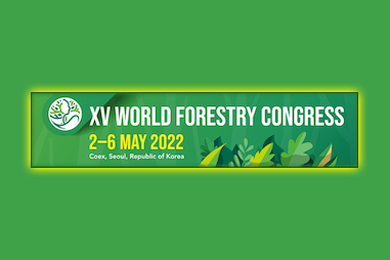John Deere Forestry Oy has been meeting logging customers’ needs for the past 50 years. The company’s commitment to the development of logging solutions has created many pioneering, productivity-enhancing innovations that make the customers’ work easier. At the exhibition they will showcase the 1010G, 1110G, 1210G and 1510G forwarders, as well as the 1070G harvester with the H212 harvester head, the 1170G 6W with the H424 harvester head, the 1170G 8W with the H423 harvester head, the 1270G 8W with the H425 harvester head, the 1270G 8W with the H424 head, and the 1470G 6W harvester with the H425 harvester head. They will also showcase the TimberMaticTM Maps and TimberManagerTM applications. New in the spotlight are the advanced map layers and a logging plan tool.
Amazingly precise terrain layouts for machine operator and logging plan needs
Logging will now have a completely new dimension with the new map layers in the TimberMatic Maps application. The new, smart map layers have been developed specifically for the needs of forest machine contractors and machine operators. Previously, TimberMatic Maps served primarily forwarder operators because of the data collected by harvester’s sensors and the precise location of the felled trees. The new map layers provide the harvester operator with clear advance information about the terrain and the tree species at the logging site.
The map layers enable interesting and high-quality work planning. The map layers facilitate in the drafting of logging plans and in everyday logging in the planning of the driving route network and the direction of the driving routes, enabling also smooth forwarder operations. The information about the terrain’s contours, moisture, tree stand length and different tree species adds interest to the harvester operator’s work. Data-based planning streamlines the work, increases the profitability of logging and helps to carry out the work in a biodiversity-friendly way. Also, the driving distances in the forest are optimized to be as economical as possible, thereby reducing fuel consumption.
TimberMaticTM Maps and TimberManagerTM have been standard features in all new John Deere G-series harvesters and forwarders since autumn 2018. Customers always receive updated versions of the applications, free of charge. The system can be retrofitted also to older machines that meet the equipment requirements.
The maps have several layers, which can also be used as overlays in planning the work.
Notifications of forest use and Tree species map
Notifications of the forest use combined with a tree species map provides a good basis for planning natural locations for groups of retention trees or for game thickets. Information about the tree stands outside the logging area facilitates the harvester operator when approaching the logging area boundary. The tree species map also shows the driving routes of previous thinnings.
Terrain map with oblique view and Storage suitability map
The map shows the contours of the terrain. The terrain map with oblique view combined with the Storage suitability map displays the areas best suited for roadside storage.
Driveability map
In addition to moisture, the map also highlights the steep slopes. The map makes it easy to assess the suitability of logging during summer, e.g., or to select the best driving routes during logging and to plan the driving route network.
Visibility map
The map provides advance information about the need to clear the stand.
Length of trees
The map shows the length of the trees, right down to an individual tree. The length map also shows the driving routes of previous thinnings.
Thinning removal
The map shows the number of trees compared to optimum growing density. The colour scale indicates the need for thinning at the site.
Tree data
In the preplanning of the logging site and in scheduling, the tree cover of the area to be harvested is essential. The map shows the total volume and the cubic volume of the area to be harvested by tree species (fir, pine and hardwood). The type of logging (final felling, first thinning, second thinning, or thinning to extend the rotation) can be specified on the map and can show with considerable precision the estimated removal by a selected type of logging.
The advanced map layers are updated free of charge in the TimberMatic Maps software and in the TimberManager cloud service. John Deere Forestry customers in Finland are the first to benefit from the use of the new map layers developed specifically for the needs of machine contractors. The maps cover the entire area of Finland.
Assistive logging site planning tool
John Deere Forestry also offers its customers an advanced tool for logging site planning; the tool facilitates the use of a wide range of information provided by several different map layers. The logging site planning tool in the TimberMatic Maps facilitates the implementation of the logging plans made in TimberManager. If a logging plan hasn’t been made in advance, it can be drawn directly in the TimberMatic Maps application. Once the area has been drawn, the entire logging site’s tree species and total volumes can be viewed and the removal estimate adjusted.
The tool’s guided planning steps support the operator in decisions on thinning and final felling, making the logging faster and of better quality. Good planning of the storage sites and the more precise timing of the produced timber species distribution streamlines the entire production and logistics chain. The machine utilization rate improves and planning the operator’s own work is easier. Preplanning the driving routes reduces the driving distances and fuel consumption, and natural sites are taken into better consideration.
The logging site planning tool will be added to the TimberMatic Maps application in September-October and to TimberManager at a later date.
IBC, a forest machine technology milestone, is already on version 3.0
John Deere’s Intelligent Boom Control (IBC) is available for all John Deere WCTL forest machines. IBC was first introduced in 2013. The latest version, IBC 3.0, introduces several operator-assist features that guide operators to the correct work methods, increase productivity and improve the machine’s resale value.
- Harvester head over-rotation prevention protects against hose damage
- Feed assist guides the operator to avoid feeding stems towards the machine or the cabin
The feed function significantly slows down when feeding stems towards the machine and stops when encountering a defined safety zone. Saw assist guides the operator to avoid sawing towards the cabin. The harvester head’s over-rotation prevention protects against hose damage. The operator-assist features and the functions that guide operators to the correct work methods also protect the machine from external damage, decrease maintenance costs and improve the machine’s resale value. IBC 3.0 is available for 1270G (H425, H425HD and H424) and 1470G (H425 and H425HD) harvester models.
The latest IBC 3.0 version is again a technology milestone because it enables the launch of future intelligent functions that facilitate the operator’s work and improve productivity.
Presenting the new single extension folding jib boom
The XE folding boom is equipped with a single extension and external hosing; it is available for CF5, CF7 and CF7S 8.5 m loaders of small and mid-size forwarders.
The structure is simple and durable, with minimal welds and bolt holes. The good geometry of the boom makes it easy to control, and the newly positioned lights under the extension increase visibility to the boom tip. The boom is narrow and flat-sided so it doesn’t damage the trees left standing. The folding jib boom’s hose routing is also better protected. Because of the Y-link shackle, the hoses from the boom to the rotator and grapple are routed inside the extension. There are no external hose loops. Productivity is also improved, thanks to the excellent tractive force of 2850 kg. The extension will be available for sale in autumn 2022, and production will start in winter 2022-2023.
XI folding jib boom for small and mid-size forwarders
The XI folding jib boom is equipped with a hidden hose extension and is available for small and mid-size forwarders 910G, 1010G, 1110G, 1210G and 1510G. The boom’s maximum reach is 10 m. The folding jib booms for older CF7 and CF7S loaders can be replaced with the new XI folding jib boom.
Further information: Elina Suuriniemi Communication Specialist John Deere Forestry Oy Tel. +358 400 466 476 SuuriniemiElina@JohnDeere.com
For other John Deere related posts click here.
For FinnMetko related posts click here.
Follow IFI on Twitter | LinkedIn | Facebook | Instagram
